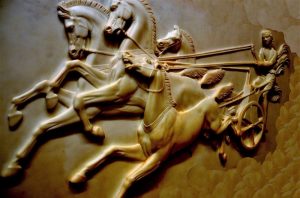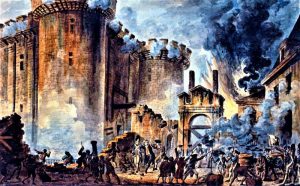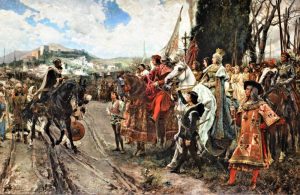Punic Wars
The Punic Wars were armed conflicts between the Carthaginian Empire and the Roman Republic between 264 and 146 B.C., which at that time were the two dominant Mediterranean countries.

Interesting data
- Dates: 264 B.C. to 241 B.C. (First Punic War), 218 B.C. to 201 B.C. (Second Punic War) and from 149 B.C. to 146 B.C. (Third Medical War)
- Confronted groups: Rome and the Carthaginian Empire
What were the Punic Wars?
Punic Wars were three major military confrontations between the two great empires of the Ancient World, Rome and Carthage. These three wars took place between 264 and 146 B.C. Confrontations took place between a commercial empire (Carthage) and an expanding one (Rome). Romans managed to defeat their enemies by equalizing and surpassing their naval army, taking advantage of their military strategies to defeat their opponents on the ground and not letting them ever recover again. After the wars, Carthage was reduced to ashes and subdued under the Roman Empire, its army, formed mostly by mercenaries could win many battles in the conflict but never managed to win the war.
The term “Punic” comes from the Latin Punicus or Poenicus which was the name given by the Romans to the Carthaginians.
Punic Wars were the biggest war clashes in the history of the classical world. The first took place between 264 B.C. and 241 B.C. The second occurred between 218 B.C. and 201 B.C. and the third occurred between 149 B.C. and 146 B.C.
Causes of Punic Wars
The cause of this war was mainly the interest of the Roman Republic in expanding southwards by conquering Sicily, a territory that was dominated by Carthaginian Empire. Carthage, located in North Africa, on the shores of what is now known as Tunisia, was a commercial empire that had an incomparable maritime army at the time, which controlled the entire western Mediterranean. However, despite having a very strong maritime force, its land army was not as powerful, and many members of its army were mercenaries fighting for money but not because they felt part of the Empire.
Rome at that time was an expanding empire throughout Italy with an identified army with its republic and had much experience in land combat strategies. Despite this, the Romans did not have a naval army as strong as the Carthaginian.
First Punic War
Date: Between 264 B.C., and 241 B.C.
Objective of the conflict: To dominate Sicily.
In 264 B.C., Rome invaded Sicily Island, which was dominated by Mamertines, a former mercenary group that had settled in those lands and served the Carthaginian Empire. In this first war between Rome and Carthage, there were many naval battles that Rome could not win until, in one of the combats, it succeeded in capturing a rowing Carthaginian ship called Quinquerreme and began to produce this type of warships in many quantities, in order to surpass the naval army of Carthage and win this first war, becoming the new masters of the island of Sicily on March 10, 241 BC.
The first Punic War ended with Romans’ victory in the battle of the Aegadian islands and the peace agreements made with the Carthaginians.
Second Punic War
Date: Between 218 B.C., and 201 B.C.
Objective of the conflict: To expand the Carthaginian Empire through the Iberian Peninsula to Rome.
The Second Punic War is known as Hannibal’s War or against Hannibal. It began in 218 B.C., and continued through 201 B.C.
Carthage was in a difficult situation after the defeat of the First Punic War. He had lost his power over Mediterranean Sea; losing Sicily and the compensation imposed on him by Rome greatly affected his economy. As a consequence, Rome had the opportunity to take control of the Carthaginian islands of Corsica and Sardinia.
Carthage decides to expand its empire by the Iberian Peninsula (Hispania) and for this reason, it counts on the general Hannibal, who proposes to initiate a new war between Carthage and Rome to finish with the Romans.
Hannibal had a large land army that included elephants. From the Iberian Peninsula it made its way to France and then to Italy. In these battles he progressively defeated the Roman army. In battles such as Trebbia and Lake Trasimeno, Hannibal demonstrated his power by annihilating the thousands of Roman soldiers.
When Hannibal arrived in Rome, he stopped and did not attack the walled city because he did not have the right army for this battle. It is important to remember that Hannibal also lost men in his combats, but not the battles he had had until that moment.
To attack Rome, Hannibal requested reinforcements from General Asdrubal, who would assist him with a second army, but this was defeated by Romans before meeting Hannibal.
Romans, for their part, followed two combat strategies developed by the Roman dictator Fabian Maximus to destroy Hannibal’s armies. The first was to keep him busy so that, he would not attack Rome. The second was to send an expedition led by general Publius Cornelius Scipio known as “the African”, to conquer the Iberian lands and finish with Asdrubal’ army.
When Hannibal found out that Asdrubal had been defeated, he tried to return to Carthage to face Publius Cornelius in Zama’s battle and lost it, putting an end to the Second Punic War.
Hannibal was able to win almost all the battles, but at the end, he lost the war, and this cost Carthage dearly, which ended up being conquered by Rome.
Third Punic War
Date: Between 149 B.C. and 146 B.C.
Objective of the conflict: To attack the Carthaginian capital by the Romans.
The Third Punic War was the last major armed conflict between Rome and Carthage. It began in 149 B.C., and ended in 146 B.C., with Carthage’s destruction by Roman armies led by Publius Cornelius Scipio Emilianus, grandson of Scipio “the African”.
By the end of the Second Punic Wars, both sides had made peace. However, Rome remained alert to its previous enemy, and knew that it could not let it resurface because that would create a new war.
Carthage, that in previous times was a commercial empire, knew how to recover from its losses after the second war and began to prosper again. But the Carthaginian people were not allowed to enter into combat with other people without the Roman Senate permission because of the peace treaty they had agreed. This is how the Romans gave secret orders to their allies in Africa to attack Carthage, and to create a confrontation that would break the peace agreement.
Carthaginians asked the Senate of Rome for permission to attack and the Romans did not allow it. This caused a lot of tension in Carthage and it was in 149 B.C. when the Carthaginians went to combat, and Rome took advantage of that moment to completely end the Carthaginian city, destroying their homes, selling the survivors as slaves and salting their land so that nothing would grow back in that place.
Consequences of the Punic Wars
The end of the Punic Wars makes Rome the main power of the Mediterranean and it puts an end to the Carthage empire in the ancient world.
How to cite this article?
Briceño V., Gabriela. (2019). Punic Wars. Recovered on 24 February, 2024, de Euston96: https://www.euston96.com/en/punic-wars/









